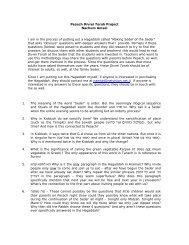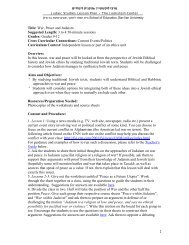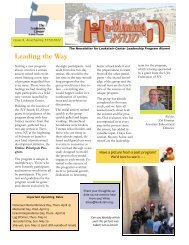FUNDAMENTAL CONCEPTS of the CLASSICAL HEBREW VERB
FUNDAMENTAL CONCEPTS of the CLASSICAL HEBREW VERB
FUNDAMENTAL CONCEPTS of the CLASSICAL HEBREW VERB
You also want an ePaper? Increase the reach of your titles
YUMPU automatically turns print PDFs into web optimized ePapers that Google loves.
Chapter 13<br />
MORE ON THE CONVERSIVE VAV<br />
Remember <strong>the</strong> midrash about Rabbi Akiva taking three friends into <strong>the</strong> pardes (<strong>the</strong> realm <strong>of</strong> esoteric<br />
philosophy), from which he alone emerged in good health? One <strong>of</strong> <strong>the</strong> o<strong>the</strong>rs died, one turned wicked, and <strong>the</strong><br />
third went insane.<br />
This chapter is not recommended to <strong>the</strong> average reader. Leave it out. It is only for <strong>the</strong> stout-hearted who are<br />
prepared to plummet <strong>the</strong> depths to get at <strong>the</strong> truth, regardless <strong>of</strong> cost. It dares to publish something <strong>the</strong> author<br />
discovered with something <strong>of</strong> a shock, and which all o<strong>the</strong>rs have ei<strong>the</strong>r not discovered or kept as a closely<br />
guarded secret: <strong>the</strong> truth about <strong>the</strong> conversive vav! This does not explain it, it merely makes it more<br />
complicated, and even more difficult to understand, but facts are facts and we cannot escape from <strong>the</strong>m. Can't<br />
we? All <strong>the</strong> grammarians seem to have done so up to now. Still, <strong>the</strong> truth cannot be suppressed for ever, so if<br />
you are prepared to take <strong>the</strong> risk, here goes. O<strong>the</strong>rwise, skip <strong>the</strong> rest <strong>of</strong> <strong>the</strong> chapter.<br />
First to recapitulate. To get an imperfective when a vav is required, we put <strong>the</strong> vav on <strong>the</strong> perfective. An<br />
ordinary vav as added, for example, to a noun, changes a perfective to an imperfective.<br />
Correct! Stick to it, remember it. That is correct.<br />
Next, to get a perfective when a vav is required, we put <strong>the</strong> vav (with a patach underneath it and followed by<br />
a dagesh) onto an imperfective. A vav with patach and followed by <strong>the</strong> dagesh changes an imperfective into a<br />
perfective. Very nice, it shows a pattern. It complements <strong>the</strong> o<strong>the</strong>r case. Only, alas, it is all completely wrong!!!<br />
The truth is that no vav, nei<strong>the</strong>r a conversive one nor an ordinary one, can be added to an imperfective!<br />
What happens is that <strong>the</strong>re are two systems. On one system, <strong>the</strong> conversive vav is added to <strong>the</strong> subjunctive to<br />
create a perfective. On <strong>the</strong> o<strong>the</strong>r system, <strong>the</strong> conversive vav is added to <strong>the</strong> subjunctive in <strong>the</strong> second and third<br />
persons to create a perfective, and in <strong>the</strong> first person it is added on to a pseudo-subjunctive apparently created<br />
for <strong>the</strong> purpose, because it is used for nothing else!<br />
You were warned at <strong>the</strong> beginning <strong>of</strong> <strong>the</strong> chapter. Do you still want to go on?<br />
Let us start with <strong>the</strong> first system. A subjunctive to which an ordinary vav is added remains a subjunctive. (On<br />
this all agree.) But if you add a conversive vav, it becomes a perfective.<br />
Here are <strong>the</strong> rules for a conversive vav, including those we left out earlier. A subjunctive, like an<br />
.א י נ ת imperfective, must begin with one <strong>of</strong> <strong>the</strong> letters<br />
(a) Before נ or ת <strong>the</strong> conversive vav takes <strong>the</strong> form וַ and <strong>the</strong> next letter (nun or tav) takes a strong dagesh.<br />
You probably knew this anyway.<br />
(b) Before י <strong>the</strong> same applies, except that if <strong>the</strong> vowel under <strong>the</strong> yod is a sheva, <strong>the</strong>n <strong>the</strong> dagesh is<br />
.וַיְהִי וַיְכַתֵּב but וַיִּכְתֹּב dropped.<br />
(c) Before א <strong>the</strong> vowel leng<strong>the</strong>ns and we have ,וָ and no dagesh.<br />
In addition, <strong>the</strong> conversive vav tends to pull <strong>the</strong> accent back away from <strong>the</strong> last syllable (it does not always<br />
succeed, but it tries), and if <strong>the</strong> last syllable loses its accent it tends to shorten. In <strong>the</strong> subjunctive it may have<br />
already shortened from <strong>the</strong> imperfective, and <strong>the</strong> conversive vav may shorten it even more.<br />
For example: Imperfective יָקוּם Subjunctive יָקֹם Conversive וַיָּקָם (vayyבkom).<br />
On this system, we remember that in <strong>the</strong> first person <strong>the</strong> imperfective tends to leng<strong>the</strong>n to produce <strong>the</strong><br />
subjunctive, <strong>the</strong> second and third persons tend to shorten, yet in many cases <strong>the</strong>re is no change.<br />
So to get our perfective we take <strong>the</strong> subjunctive and get things like this:<br />
וָאֶכְתְּבָה וַתִּכְתֹּב וַיִּכְתֹּב וַנִּכְתְּבָה וַיַּבְדֵּל וָאֵרְדָה וַתֵּרֶד וָאֶפְנֶה וַתֵּפֶןְ וַיִּפֶן<br />
This is <strong>the</strong> system generally used by Ezra and Nehemiah. Moses tended to prefer <strong>the</strong> second system, with rare<br />
.(וַנַּחַלְמָה Gen. 41:11 exceptions (e.g.<br />
In <strong>the</strong> second system, <strong>the</strong> second and third person are <strong>the</strong> same as on <strong>the</strong> first system, <strong>the</strong> usual subjunctive.<br />
But for <strong>the</strong> first person, instead <strong>of</strong> <strong>the</strong> subjunctive which tends to leng<strong>the</strong>n, a pseudo-subjunctive is formed by<br />
shortening in <strong>the</strong> same way as <strong>the</strong> actual subjunctive shortens in <strong>the</strong> second person; and if <strong>the</strong> second person<br />
cannot shorten, nor does <strong>the</strong> first, but it does not leng<strong>the</strong>n. This pseudo-subjunctive is what is used, not for a true<br />
subjunctive but instead <strong>of</strong> it for <strong>the</strong> conversive. (Once again, you were warned.) The forms corresponding to<br />
those given above are as follows:<br />
For a good example <strong>of</strong> this, see Deut. 9:15-16.<br />
וָאֶכְתֹּב וַתִּכְתֹּב וַיִּכְתֹּב וַנִּכְתֹּב<br />
וַיַּבְדֵּל וָאֵרֵד וַתֵּרֶד וָאֵפֶן וַתֵּפֶן וַיִּפֶן

















